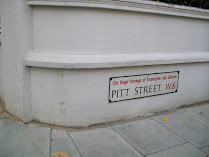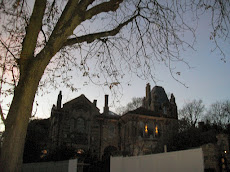A return to ‘the great cesspool into which all the loungers and idlers of the Empire are irresistibly drained’, London, to visit some North London Sherlockian sites. I made my way by bus and tube to Notting Hill Gate, well known to me for its secondhand shops. A short walk brought me to Peel Street, which has been identified as the ‘line of fine houses lying in the vague borderland between Notting Hill and Kensington’ in which Mr. Culverton Smith’s home was located in ‘The Dying Detective’. There are houses on this street that meet the description of Culverton Smith’s house: ‘old fashioned iron railings, massive folding door and shining brasswork’. David Hammer identified Culverton Smith’s residence as being one of those on the corner with Campden Hill Road.
A five minute walk took me to Pitt Street which was where both the residence of Horace Harker and ‘Harding Brothers’, the store where he purchased his Napoleon bust, were located in ‘The Six Napoleons’.
‘In half an hour we had reached Pitt Street, a quiet little backwater just beside one of the briskest currents of London life. No. 131 was one of a row, all flat-chested, respectable, and most unromantic dwellings. As we drove up, we found the railings in front of the house lined by a curious crowd. Holmes whistled. “By George! It's attempted murder at the least. Nothing less will hold the London message-boy” ’. [SIXN]
H.W. Bell identifies No. 14 as the Harker residence (No. 131 not existing).
A further five minute walk took me to High Street Kensington station, where I caught a District Line train to Edgware Road. It was then another short walk along Edgware Road, until I reached the Old Marylebone Road, and St. Mark’s Church (called ‘St. Monica’s’ by Watson)
Continuing up Old Marylebone Road, I turned onto Marylebone Road which runs up to Baker Street Station. Walking a short distance, I turned onto Lisson Grove, just before reaching the Landmark Restaurant, the exterior of which was used for the restaurant in ‘Sherlock: The Empty Hearse’ where Sherlock reveals himself to John.
A long walk up Lisson Grove finally led to my reaching Elm Tree Road, and number 33 which was the location of ‘Bryony Lodge’, where Irene Adler lived, and where Holmes managed to trick her into revealing the hiding place of an incriminating photograph in ‘A Scandal in Bohemia’. There was also a staged fight on the roadway outside.
Another short walk brought me to a bus stop where I caught a #46 to Hampstead Station. From here it was a ten minute walk to East Heath Road, and 'The Logs', believed to be 'Appledore', where 'the worst man in London', Charles Augustus Milverton, lived in the story of the same name, a property that Holmes and Watson attempted to burgle.
This property also has another Sherlockian claim to fame as it was being lived in by Marty Feldman (and his wife Loretta), when he appeared as Orville Sacker (a name based on ACD’s original name for Watson) in ‘The Adventures of Sherlock Holmes Smarter Brother’ (1975). There is a pleasing symmetry to this, as the film’s Eduardo Gambetti (played by Dom DeLuise) ‘the cleverest of the blackmailers’ was clearly modelled on Milverton, ‘the king of blackmailers’.
Darkness was descending, so I decided to put off my planned visit to Highgate Cemetery and the grave of Adam Worth (1844-1902) widely considered the inspiration for the criminal mastermind Professor James Moriarty, to another day. I therefore made my way back to Hampstead Station, catching the Northern Line back to Morden, and then catching a bus home.












No comments:
Post a Comment